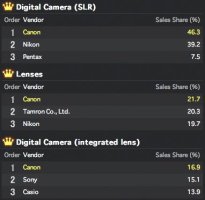Another "rumors" site focused on a brand that shall remain nameless but which starts with "N" says Tamron has moved into the #2 spot among lens makers in Japan.
That's pretty impressive, especially since their lineup is fairly limited. Tamron's two top lenses are their 18-270 all-in-one and their new 70-300 zoom. This makes me wonder if we won't see an all-in-one soon from Canon and also, I wonder, if we are due for an upgrade to the non "L" Canon 70-300mm IS. And, if we are, I wonder how Canon improves on this lens without hurting the "L" version.
Of course they can leave off the weathersealing, but it seems like they would need to improve the optics, IS and maybe the focusing. But, they might be worried about hurting sales of the "L" version, which I suspect haven't been all that stellar anyway. On the other hand, they may figure the two are focused on such different markets, if they can sell five or six non "L" versions for every one "L" it might be worthwhile.
What do others think?
That's pretty impressive, especially since their lineup is fairly limited. Tamron's two top lenses are their 18-270 all-in-one and their new 70-300 zoom. This makes me wonder if we won't see an all-in-one soon from Canon and also, I wonder, if we are due for an upgrade to the non "L" Canon 70-300mm IS. And, if we are, I wonder how Canon improves on this lens without hurting the "L" version.
Of course they can leave off the weathersealing, but it seems like they would need to improve the optics, IS and maybe the focusing. But, they might be worried about hurting sales of the "L" version, which I suspect haven't been all that stellar anyway. On the other hand, they may figure the two are focused on such different markets, if they can sell five or six non "L" versions for every one "L" it might be worthwhile.
What do others think?

